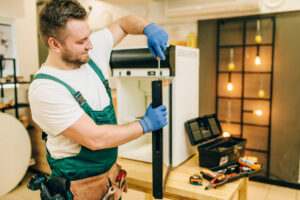Are you a DIY person? Do you like to save a few dollars by installing your own appliances?
Although you can save money by installing them yourself, there are some obstacles that you may be facing but aren’t aware of.
It might be confusing to install major appliances and I have listed some mistakes that you can avoid.
1. Not asking for an on-site visit
It’s important to have the customer service representative who will be performing the installation come out for an on-site visit.
This will allow them to ensure that their technicians are properly trained and equipped with the right tools and parts.
It also gives them a chance to do a walkthrough of your home so they can see how things might fit into place once they’re installed.
2. Unrecognized risks from high voltage
When installing an appliance with an electrical connection, there is always some risk of electrical shock or fire.
This risk increases when the installer does not recognize it and take precautions such as using rubber gloves and working safely around high voltage wires.
If you’re planning on installing any type of high-voltage equipment — including electric ranges, dryers, water heaters or space heaters — make sure that you hire a professional to complete the installation.
3. Faulty installation of a new appliance
Appliance manufacturers provide instructions for how to install their products.
If they don’t, you should still follow the guidelines they use to ensure that the product is installed properly and safely.
For example, if you are installing an electric range or oven, you need to make sure that any gas lines are properly connected and that your electrical outlet is strong enough to handle the load of your new appliance.
If you don’t know what to look for when installing an appliance, make sure you ask for help from someone who does know what they are doing.
4. Bad infrastructure
The first thing you need to consider when installing an appliance is your existing infrastructure.
If your home was built before 1970, then there may be some problems with the electrical wiring or water supply that could make it difficult to install certain appliances.
Check out our article on making sure your house has enough power to run your new appliances.
5. Improper safety precautions
Safety should be your number one priority when installing appliances.
Make sure that you have all the necessary tools and equipment on hand before starting the job.
Check for loose wires and frayed cords, as well as any sharp edges or other hazards that could cause injury if touched or contacted by someone else during use.
6. Poorly installed electrical work
Badly wired appliances may be dangerous and won’t function correctly. Have an electrician install the wiring for your new appliance.
Improper use of extension cords is also related to that – Don’t use an extension cord as a permanent power source for an appliance; it could cause a fire or shock hazard. Instead, get a longer electric cord that will reach from the outlet to your appliance.
7. Failed water and gas pipes (or gas line)
One of the most common cause of failure is a failed water pipe or gas line.
This can happen if the plumber doesn’t use the right tools to cut through these lines, which are made of metal and are often difficult to cut with a saw.
If these pipes fail, they will leak and cause serious damage to your home. It’s important that you know what type of pipes are in your home before you buy an appliance or make any changes that could affect them.
8. Problems with the new flooring
Another common problem involves damage to the flooring during appliance installation.
If your technician doesn’t take care when moving appliances around on their dollies, they could easily scuff or scratch your hardwood flooring or carpeting.
This kind of damage is often difficult to repair and may require replacing some of your flooring if it’s too severe, and might cause some damages to your dream home.
9. An untested appliance
This is one of the biggest problems you will face when you hire someone to install your appliance.
It is important that you get an appliance that has been tested for all of its features before being installed in your home.
This will save you from having to pay twice for repairs later on.
10. Installing a dishwasher in an ice maker zone
This is the most common mistake made when installing a new dishwasher.
If you’re going to be using an ice maker and have a large family, you may want to install your dishwasher in another room so that it does not freeze or damage your appliance.
The first step is deciding where to put your dishwasher.
You need to make sure that there’s room behind it for water and drainage lines, as well as room between the back wall and the ceiling for the vent pipe.
The second step is finding out if your home has an ice maker zone or not.
Ice maker zones are usually located on one side of the kitchen sink and are used for refrigerators or freezers that make ice cubes.
Listed above are perhaps some of the most important things to keep in mind when you go to mount your new appliances.
By doing your research and being thoughtful about your selection, you can avoid the most common mistakes and end up with an ideal appliance and installation at a fair cost.



